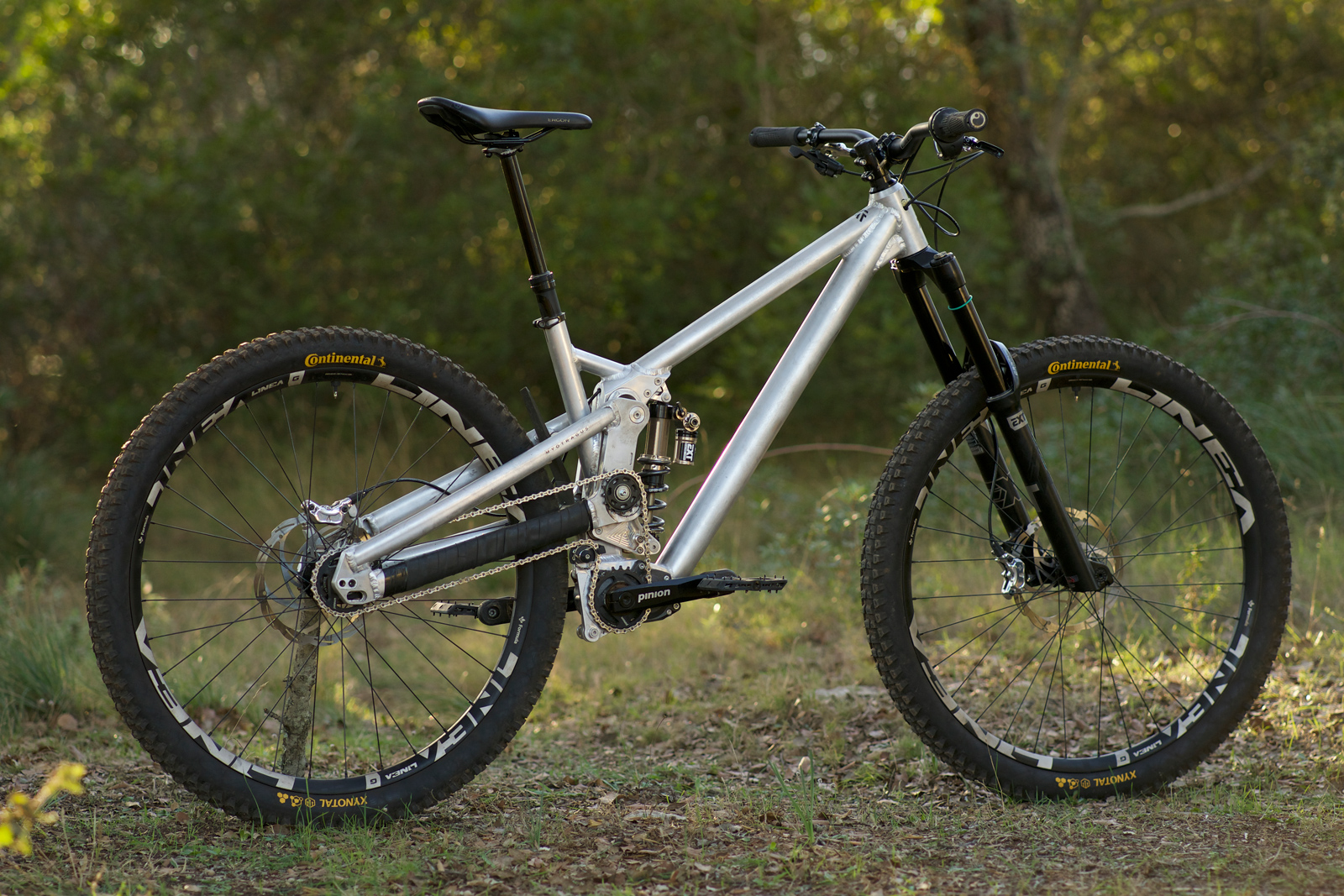Myotragus, an emerging Mallorcan mountain bike brand named after an extinct mammal known only to have inhabited the Balearic Islands of Mallorca and Menorca, is very close to releasing its debut framesets; the Dorothea 20 DH Bike, and the Dorothea 17 Enduro Bike. Rather appropriately, the Myotragus Bikes are named after Dorothea Bate, the Welsh paleontologist who unearthed the creature in 1909. Historical references aside, the Dorothea DH prototype stole our attention with its unusual execution of a virtual high-pivot twin-link suspension platform that delivers an almost straight-line rearward axle path.
Roger Pisà, a Mallorcan DH and Enduro Rider, is the mind behind the patented OLS Suspension Linkage. He worked closely with Barcelona-based engineer, Joan Bujosa, to execute his ideas and bring his dream bikes to reality. The frameset is still under development as the team await their first samples of the V4 prototype. Though gearbox framesets are shown throughout, final production will bring a traditional drivetrain option to market also. We hopped on a call with Joan Bujosa to learn more about these exciting new bikes.
Myotragus Dorothea

The idea of the Myotragus Dorothea was born over 10 year ago when founder, Roger Pisà, embarked on an exploratory journey to design a mountain bike suspension platform that would deliver a straight-line axle path, via a twin-link arrangement wherein the lower link rotated anti-clockwise as the rear wheel was displaced by a bump. Not only that, but he wanted that straight-line axle path to move rearward only.
Noting that a rearward axle path would result in a growing rear-center length and thus, chain growth, Roger realized the use of an idler pulley would be necessary to manage anti-squat and pedal kickback. He reasoned the best place to locate the idler pulley would be on the lower link, such that its position would move in concert with the movement of the swingarm as the bike was pushed into compression.

At this point, with his ideas having not yet materialized beyond his own thoughts, Roger decided he needed the advice of an engineer who would be able to mathematically explain why the theoretical straight-line rearward axle path would offer performance advantages on the trail. It is intuitive that an axle path that moves in line with the direction of the forces applied to the rear wheel, rather than in opposition to them (think low single-pivot), would be most effective at absorbing and damping those forces, but Roger wanted to rely on something more than simple intuition.
Enter Joan Bujosa, a friend of Roger’s who had recently completed a Degree in Engineering. While not a rider himself, Joan tells us that “Roger’s idea made real sense, real physical sense; the things he was saying, I found they could be supported by physics or mechanics”. From that point on (around 2015), Joan began working with Roger to make his dream bike a reality.
Early on, the two considered manufacturing the Myotragus bikes with titanium lugs and carbon tubing, much like the bikes of Robot Bike Co, but were put off by the incredibly high price of manufacture. They wanted to produce more affordable framesets, so have instead partnered with aluminum frame manufacturer, Campmajó Bikes (known for their full suspension tandems), a Catalonian bicycle brand operating out of Tarragona.
OLS Suspension
Having produced, validated and patented his suspension design, Roger’s OLS Suspension Platform has come to fruition on the Myotragus Dorothea 17 Enduro Bike (V3) where it delivers 175mm of rear wheel travel (200mm on the DH Bike). It sees a high virtual pivot twin-link layout, but its execution is rather out of the ordinary. What drew our attention to this bike in the first place was the eccentric axle about which the upper portion of the swingarm articulates. While it may look complex, it functions much like a very short-link.
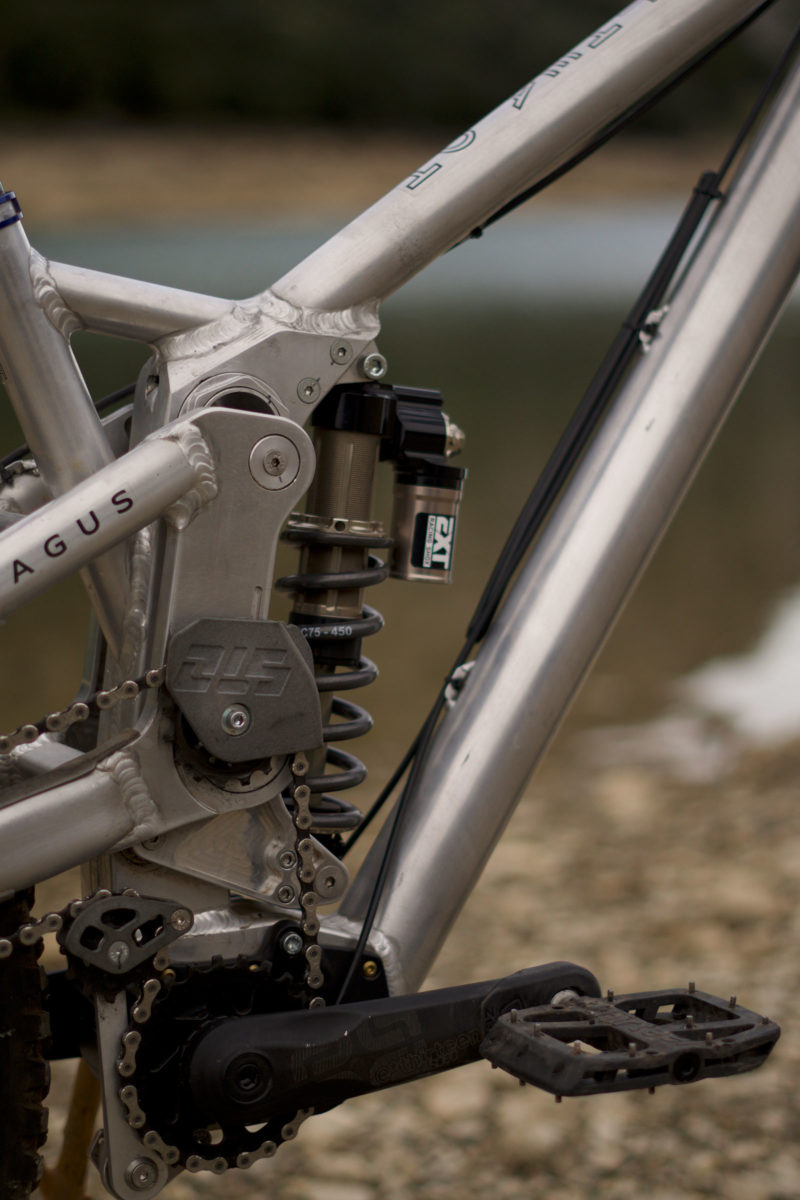
As the rear wheel is displaced, the lower link rotates anti-clockwise to drive shock compression, while the upper link pivots eccentrically about a very large bearing housed between the seat tube and the top tube. The upper pivot on the swingarm moves forward and up initially, and then down and rearward again as the shock is pushed deeper into compression. In this way, Joan and Roger were able to control the arc of the rear axle path such that it is very close to a straight-line.
The result? The rear axle only ever moves rearward. The considerable chain growth associated with such a design necessitates not only an idler pulley on the lower link, but also, given that this bike runs a Pinion Gearbox drivetrain, a very long-arm chain tensioner aft of the chainring.
I hear you. You want a slow-motion video of the suspension articulating. Here it is!
All that said, Joan tells us that Myotragus will do away with this upper pivot design on the V4 for ease of fabrication, and to make sure that it will be more simple to service and find replacement parts when the time comes to change the frame bearings. The render below shows the form that the production Dorothea will likely take, with a short-link replacing the eccentric axle pivot on the front triangle. Joan says the axle path is slightly affected by this change, but not significantly so.
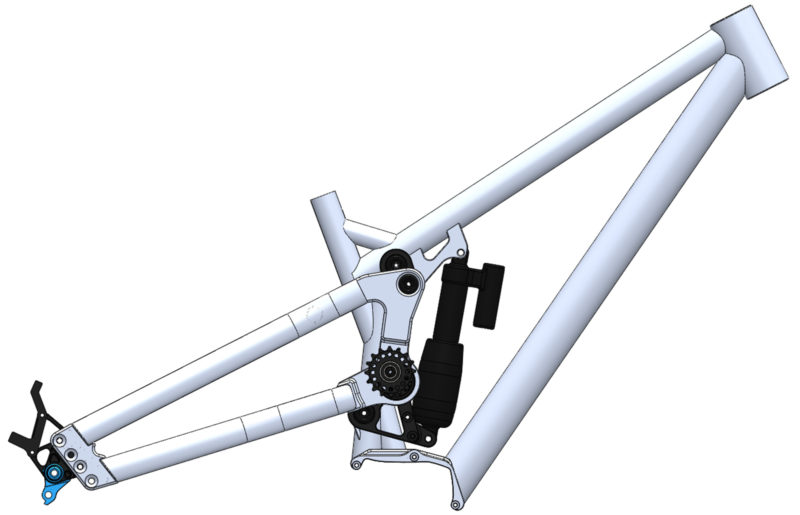
The Dorothea’s axle path is really quite different to the rearward axle paths we’ve seen on other, more mainstream high-pivot bikes. These are more arced, such that the rear-center length grows more early on in the stroke, but begins to arc forward again toward bottom-out. A notable exception would be the Forbidden Dreadnought. As the axle path is closer to that of a straight line, the Dorothea’s rear-center length grows more gradually, but the very shallow arc means that it never begins to track forward. On the 200mm travel DH bike, the rear-center length grows by a massive 57mm.
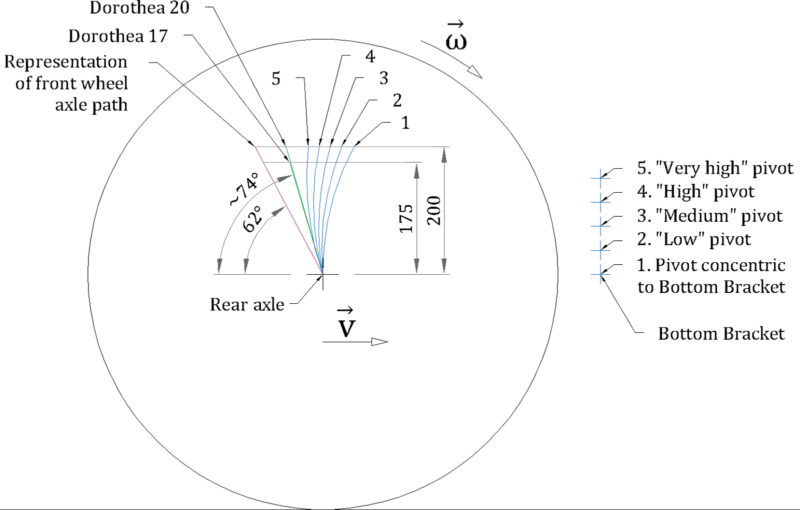
In fact, the path taken by the rear axle is more similar to the path taken by the front axle of a regular telescopic fork, as shown in the above graph provided by Joan. The bike’s wheelbase still shortens during compressions that involve the front and rear wheels simultaneously, as the 62° head tube angle on the DH bike is much slacker than the effective ~74° angle of rear axle displacement.

As you might imagine, such an axle path results in some unusual anti-rise and anti-squat plots.
In particular, while the anti-rise starts out at a fairly standard 130% (for high-pivot bikes) around the sag zone, it actually increases the further the rear wheel is displaced into its travel. That’s the exact opposite of what we see on other high-pivot bikes where anti-rise falls off as you go deeper into the travel.
What does that mean for the Dorothea’s performance on the trail? Theoretically, the bike will have a greater tendency to compress into its suspension travel during braking events that occur deeper in the stroke. Arguably, it’s not so relevant, since most of riders are doing most of their meaningful braking around the sag zone anyway.
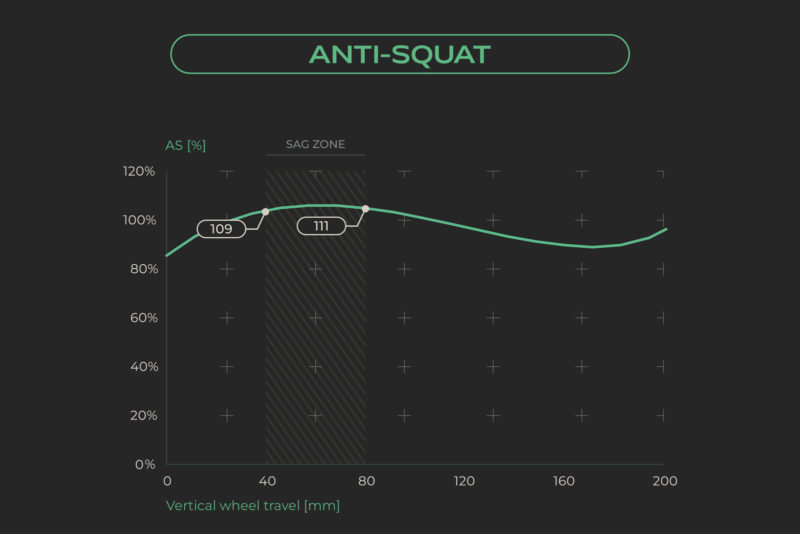
Anti-squat values are more consistent throughout the 200mm travel on the Dorothea DH frame, sitting at around 100% through the sag zone, then decreasing thereafter. Thus, around sag, pedal kickback should be kept to a minimum.
What about the leverage curve?
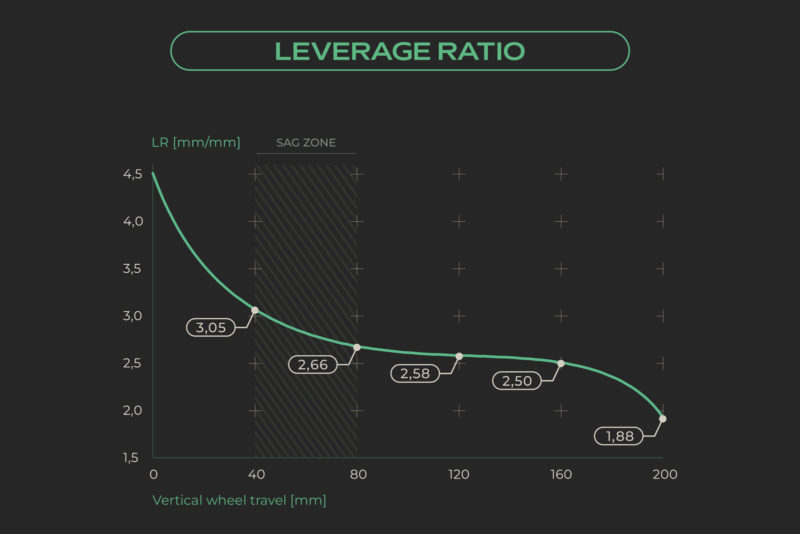
Offering up more insight into how the bike may perform on the trail is the leverage curve. The Myotragus Dorothea’s OLS Suspension Platform has a 58% overall progression. It is very progressive early on in the stroke until it hits a ratio of 3.05-2.66 around the sag zone. From here, the mid-stroke support sits around 2.55 until it becomes very progressive again toward bottom-out. Joan tells us they don’t mind the bike never using, for example, the last 3mm of travel, if that means the rider never experiences a harsh bottom-out event.
The above leverage curve pertains to the Dorothea 20 DH Bike. The 175mm travel Dorothea 17 Enduro Bike leverage curve will not be dissimilar in shape; Joan says the highly progressive initial stroke and end-stroke will be reduced to produce a curve with much less overall progression (41%).
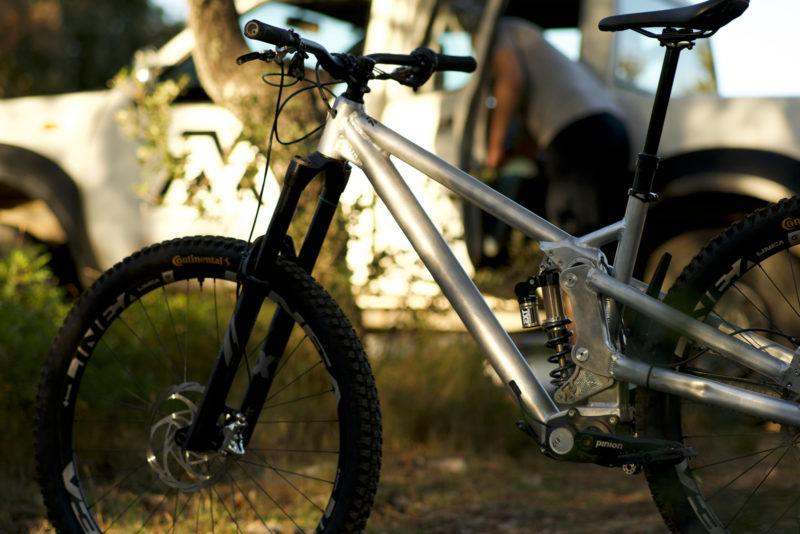
All that said, Myotragus plan to make progression adjustable on the V4 with two possible shock mounting locations on the lower link. As compared to the leverage curve seen above, the alternate shock mounting position will deliver a curve with lower overall progression. The team is also considering two potential mounting positions for the upper shock.
Myotragus Dorothea Geometry

Myotragus plans to offer two standard sizes for the Dorothea; a ~450mm reach, and a ~480mm reach. That said, the two-man brand is willing to work with each customer and a bike fitter to deliver a custom-sizing option for those who need it. Also, dependent on the customer’s weight, riding style, and intention for the Dorothea (DH or Enduro), Myotragus can tailor a lighter, more compliant tubeset, or a heavier, stiffer tubeset. Joan tells us the production bike will be able to run a 29″ or 27.5″ rear wheel, with adjustments available to negate its impact on the geometry.
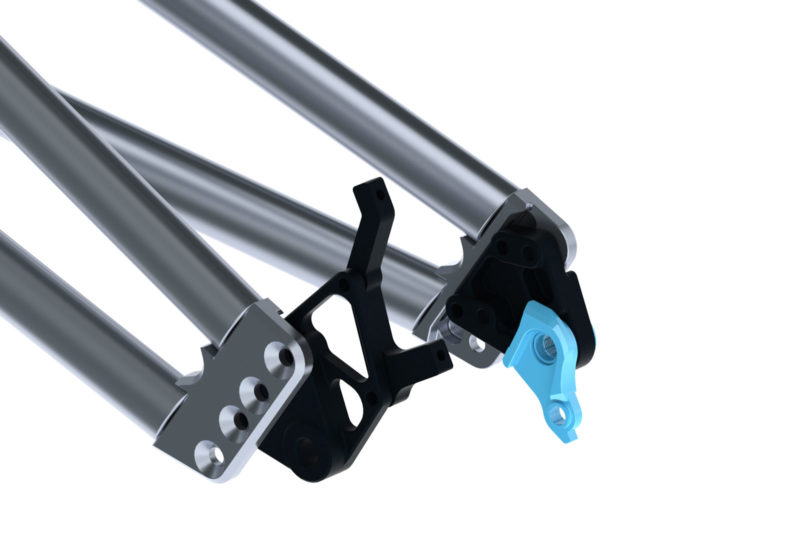
Four chainstay positions will be offered; two for a 29″ rear wheel and two for a 27.5″ rear wheel. For the former, chainstay lengths of 435mm and 450mm are available. For the latter, chainstay lengths of 435mm and 420mm are available. It’s worth mentioning again that the rear-center length will grow by 57mm throughout of the full stroke of the suspension, if only to realize that the 450mm chainstay will grow to an effective 507mm at bottom-out!
When can I buy one?
Joan and Roger are unsure on timescales at the moment, given that they will still need to test and validate the Myotragus Dorothea V4 currently being fabricated by Campmajó Bikes. Thereafter, it will go to ISO testing before it will be available for pre-order. The pair are aiming to sell the Dorothea at around 2,700-3,000 € for a frame without shock.
